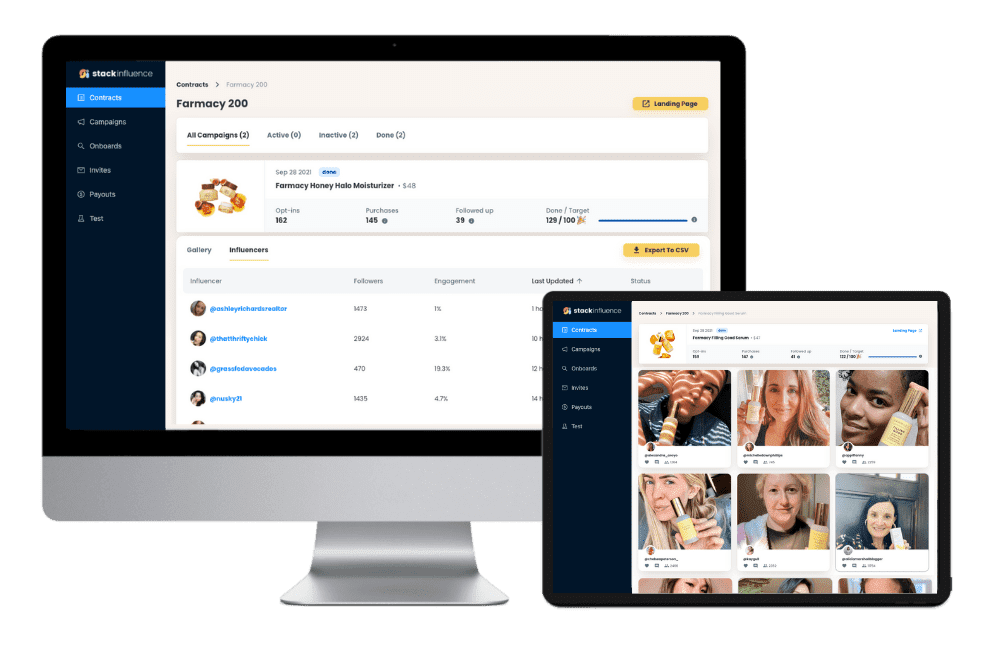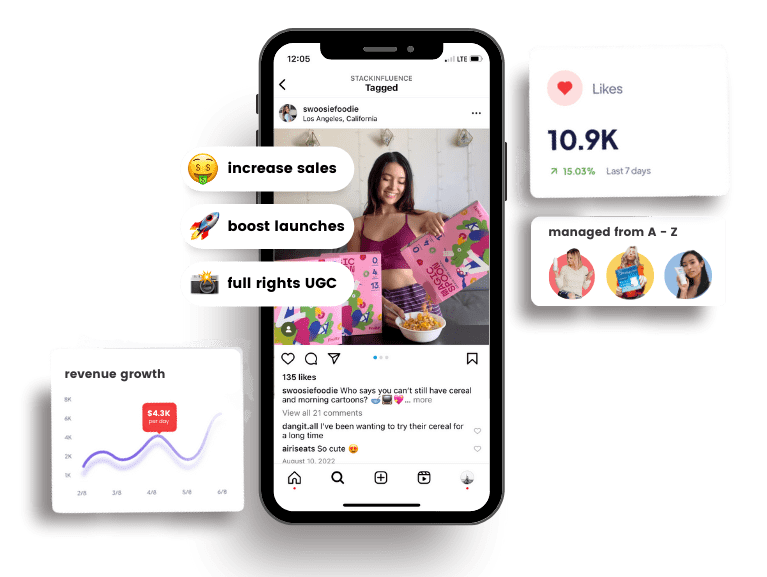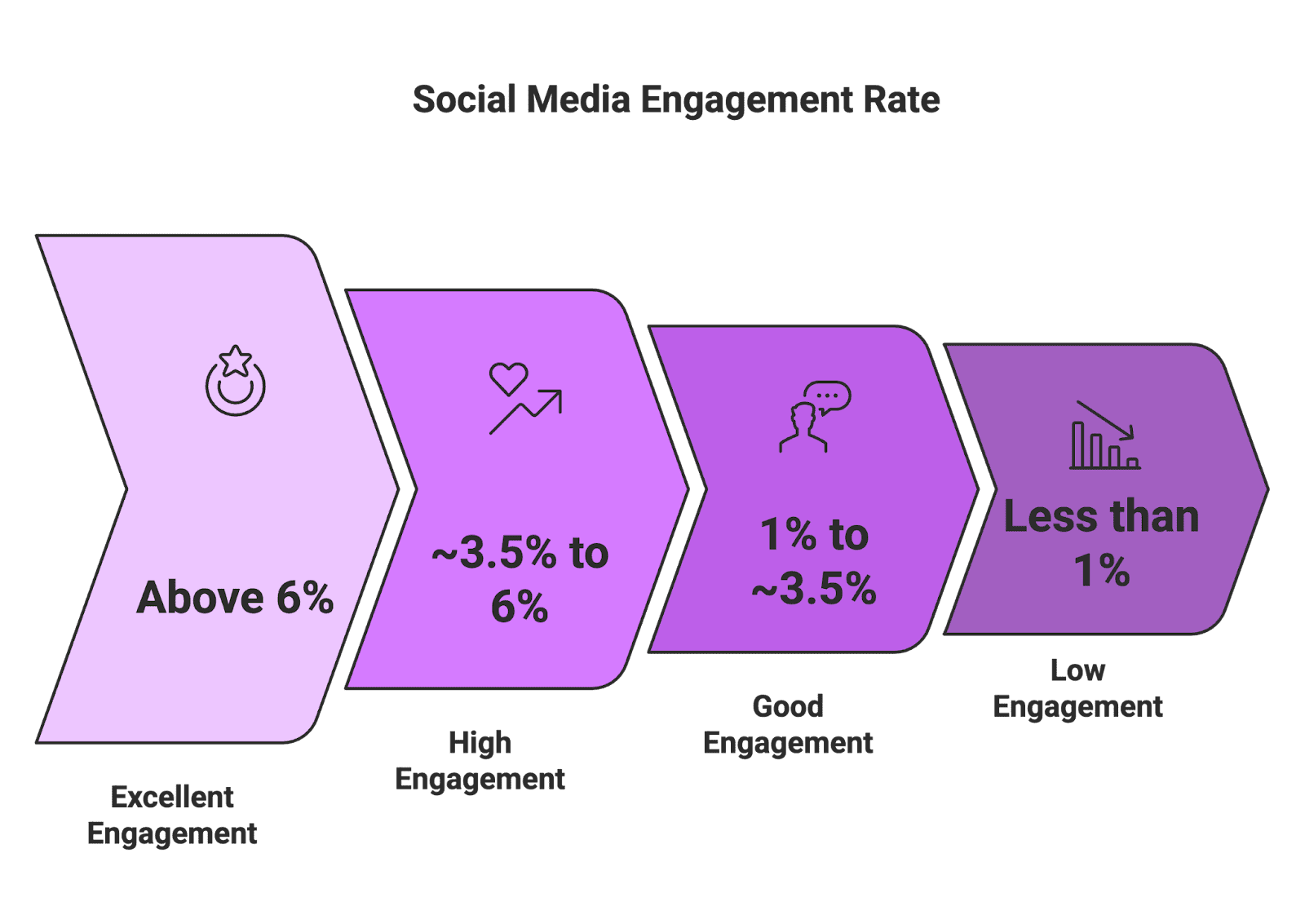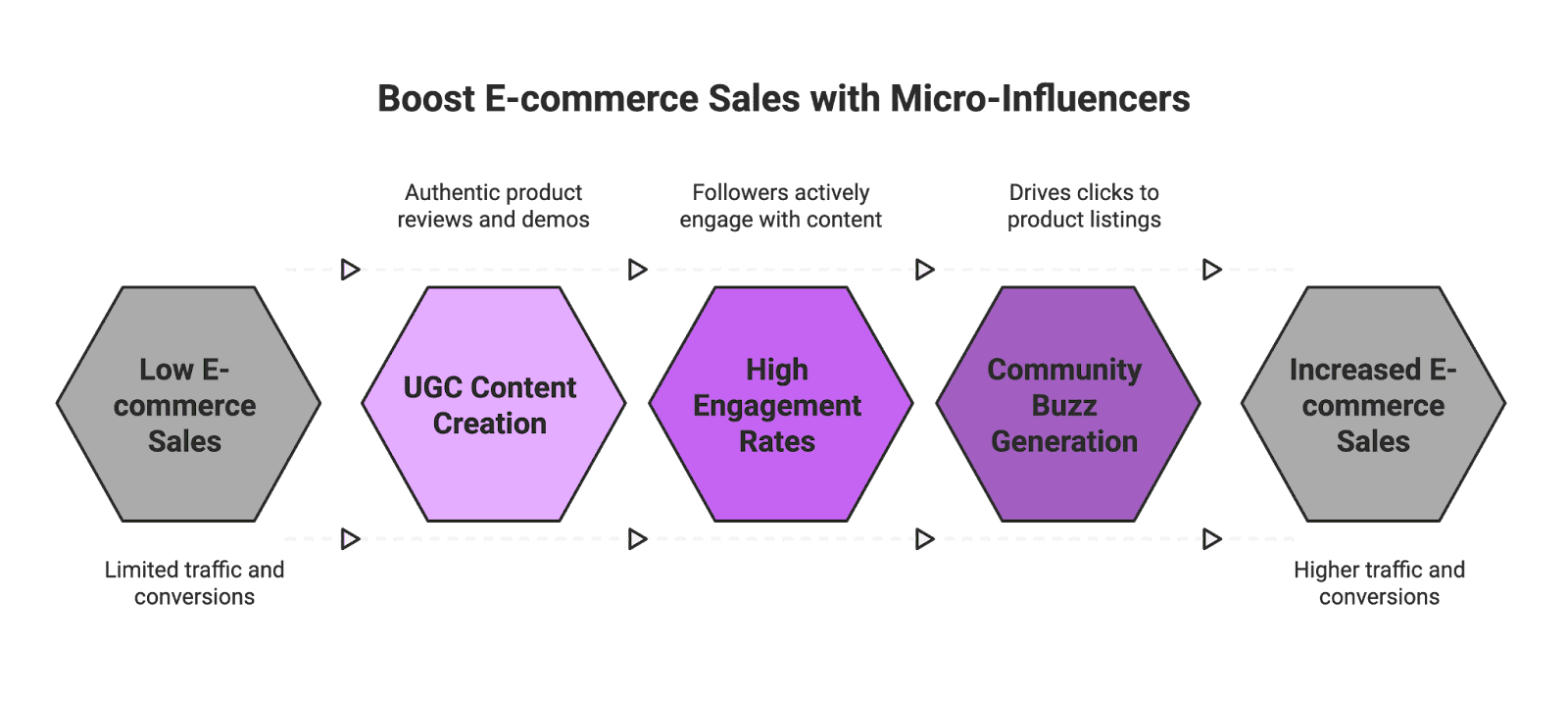What Is a Good Engagement Rate? (Guide for Influencers & E-Commerce Brands)
12th
August, 2025
Influencer Marketing
Amazon Marketplace
Artificial Intelligence
TikTok Tips
In today’s social media-driven marketplace, e-commerce brands and Amazon sellers are partnering with micro-influencers to generate authentic user-generated content (UGC) and drive up engagement. A high engagement rate on content – as shown conceptually above – can translate into more trust, traffic, and sales for online businesses.
What is Engagement Rate?
Engagement rate is a metric that measures how actively your audience interacts with your content. In simple terms, it’s the percentage of people who engage with a piece of content out of those who saw it or follow you. Engagements include actions like likes, comments, shares, saves, retweets, clicks, and other meaningful interactions – basically anything beyond just viewing the content. A higher engagement rate means a larger portion of your audience is responding to your posts, which is often a sign that your content resonates with them.
How to calculate it: The most common formula is:
Engagement Rate = (Total engagements / Total followers) × 100
For example, if you have 10,000 followers and a post gets 300 combined likes, comments, and shares, that post’s engagement rate is 300/10,000 × 100 = 3%. (Some marketers calculate by post impressions or reach instead of follower count, but the goal is the same – to find what percentage of your audience is interacting with your content.) Generally, views alone are not counted as engagement; it’s the active responses that matter.
Why Engagement Rate Matters
Engagement rate isn’t just a vanity metric – it’s a core indicator of content performance and audience connection:
- Measures Content Resonance: A strong engagement rate shows your content is striking a chord with your audience. If people bother to like, comment, or share, it means your posts are meaningful or interesting to them. In fact, engagement illustrates the strength of the relationship with followers – if they’re regularly interacting, they’re more likely to trust you and even become customers down the line.
- Algorithm Boost & Visibility: Social platform algorithms love engagement. Posts with higher engagement are more likely to be surfaced to others – for example, Instagram’s algorithm favors content that “sees tons of engagement” for the Explore page. Essentially, engagement = more reach, as networks treat it as a signal of quality. A good engagement rate can thus improve your organic visibility and help attract new eyeballs to your profile.
- Social Proof & Trust: When users see a post with lots of likes and comments, it serves as social proof that people find value in it. This builds credibility for content creators and brands. A profile with an engaged community appears more trustworthy and authentic than one with a million silent followers. Remember, authenticity is huge – nearly 90% of consumers say authenticity is important when deciding which brands to support. UGC and real interactions signal authenticity, which in turn increases consumer trust.
- Influencer Marketing Value: For brands evaluating influencers (or creators evaluating their own performance), engagement rate is often the number-one factor. Marketers report that engagement (likes, comments, clicks) is the most important metric when choosing influencers to partner with. A high engagement rate suggests an influencer has an active, responsive audience – which is far more valuable than a large follower count with low interaction. In short, engagement rate helps predict if content will drive results. It’s no surprise that influencers are often contracted for their engagement even more than their follower count.

Unlock the Power of Micro Influencers and Elevate your Brand Today!

What Is a “Good” Engagement Rate?

Determining a “good” engagement rate depends on a few key factors – platform, industry, and audience size – but there are some general benchmarks we can use as a rule of thumb. Broadly, social media experts often consider an engagement rate between about 1% and 5% to be good or average. Here’s a common breakdown used in the industry:
- Less than 1% – Low engagement rate. This may be a sign to re-evaluate your content strategy, targeting, or consistency, as very few followers are interacting with your posts.
- 1% to ~3.5% – Average or good engagement rate. Many brands and creators find themselves in this range. It shows a decent level of interest from your audience, about typical on most platforms.
- ~3.5% to 6% – High engagement rate. Anything in the upper-single digits indicates your audience is highly engaged with your content. Posts are getting strong interaction, which suggests a loyal and interested following.
- Above 6% – Very high (excellent) engagement. This is top-tier engagement that only exceptional content or highly targeted audiences tend to achieve consistently. If you’re hitting 6%, 10%, or more, you’re doing really well – especially as your follower count grows.
Keep in mind, these are ballpark figures. What’s “good” can vary by platform and niche. For instance, a 3% engagement rate on Instagram might be normal, but 3% on Twitter (now X) would be extraordinarily high. Always compare yourself to relevant peers – for example, other beauty brands on Instagram, or other tech YouTubers – rather than to a blanket number across all of social media.
Also, note that engagement rates tend to decline as follower counts rise. It’s simply harder to keep a huge, diverse audience as engaged percentage-wise as it is to engage a small, tight-knit community. In fact, smaller accounts often have more focused and passionate followers, so their engagement ratio is higher. Don’t be discouraged if a mega-celebrity has “only” a 1% engagement rate while a niche micro-influencer gets 5% – that’s a normal dynamic. We’ll explore this more in the Micro vs. Macro section below.
Engagement Rate Benchmarks by Platform
Not all social networks are created equal when it comes to engagement. A “good” engagement rate on one platform might be average on another. For example, Instagram and TikTok posts generally garner a lot more interaction than Twitter posts. LinkedIn’s engagement is a different ballgame as well, often involving longer comments and shares rather than quick likes. It’s important to understand the typical engagement norms on each platform you use.
To put things in perspective, let’s look at average engagement rates by platform (across all industries and account sizes):
Average engagement rate by platform (all industries, Q4 2024 data). Instagram and TikTok see around a 2% average engagement on posts, whereas Facebook and Twitter (X) generally see under 2%. Professional-networking content on LinkedIn tends to have slightly higher average engagement (~2.8%).
As the chart above shows, Instagram posts have roughly a 2% average engagement rate, and TikTok is similar around 2% on average, although top-performing TikToks can go much higher. Facebook and Twitter (X) typically see lower engagement (often 1-2% or even below 1% for Twitter) since these platforms are more about quick scrolling and link sharing. LinkedIn, interestingly, can see higher averages (~2-3%) because the content is often niche and the audience smaller (e.g. a post in a specific industry group may get a high percentage of that group interacting). On LinkedIn people tend to either engage thoughtfully or not at all, so engagement is less frequent but can be proportionally high when it happens.
Why the differences? Content format and user behavior vary by platform. Instagram is visual and encourages quick double-taps and comments, while TikTok’s addictive video feed can drive rapid engagement (shares, comments) especially when content goes viral. Twitter’s fast-paced text feed results in lower engagement ratios – people might read a tweet and move on without interacting, leading to tiny percentages (an engagement rate above 0.1% on Twitter can actually be decent in many cases). On the other hand, TikTok is currently known for its high engagement levels – TikTok’s average engagement rate is generally higher than Instagram’s at the moment, thanks to its algorithm that pushes content to the “For You” page beyond one’s followers. The key takeaway is to always benchmark against the same platform. Don’t panic if your brand’s 3% Instagram engagement looks “lower” than someone’s 5% on TikTok – that could actually be normal given platform trends.
Lastly, industry and content niche affect engagement too. Fun, visual topics (like fashion, food, or pets) often see higher engagement rates than technical or corporate topics (like finance or B2B software). A quirky meme account might regularly hit 5-10% engagement, while a government or banking industry account might celebrate hitting 1-2%. Always compare apples to apples: look at engagement norms in your specific field.
Engagement Rate by Follower Count (Micro vs. Macro Influencers)
Another crucial factor in engagement rate is the size of the audience. Generally, the smaller the follower count, the higher the engagement rate (in percentage terms). This is why micro-influencers (those with tens of thousands or fewer followers) often boast better engagement than mega-influencers with millions of followers. Their audiences are more niche, loyal, and attentive. By contrast, big celebrities have huge followings that include many casual viewers who don’t interact as much.
For example, one analysis of Instagram found that micro-influencers (say 10k–100k followers) had an average engagement rate around 3.8%, whereas macro-influencers (500k+ followers) averaged only about 1%. In other words, the smaller creators were getting 3-4 times higher engagement relative to their audience size. This trend holds across platforms and studies: another report noted micro-influencers typically achieve roughly 60% higher engagement rates than macro-influencers on average. Smaller creators tend to have a close-knit community feel – followers see them as genuine peers or friends, not distant celebrities, which leads to more interaction.
Example of engagement rates for micro-influencers (from an influencer platform dashboard). Smaller creators often have very high engagement percentages – as shown above, an account with only ~1,400 followers can see an engagement rate of 47%! These unusually high rates reflect highly invested niche communities, and they typically decrease to more “normal” percentages as an influencer’s follower count grows.
The flip side is that as influencers grow, their engagement rate % usually dips. A nano-influencer with 800 followers might get 100 likes (a 12.5% rate), but if they grow to 80,000 followers, they are unlikely to still get 12.5% engagement on each post – that would be 10,000 likes per post, which only the most exceptional content achieves. Instead, they might get say 1,600 likes (2%), which is still strong at that scale. This phenomenon is natural and comes from audience dilution and platform algorithms. The key point: don’t compare a big influencer’s 2% to a tiny creator’s 10% and assume the big one is underperforming. Different scale, different expectations.
For brands, this is why micro- and nano-influencers are so attractive – collectively, a group of smaller influencers can generate higher engagement and authenticity than one or two big names. In fact, many marketers now prioritize micro-influencers because of their high engagement and cost-effectiveness. (Why pay a celebrity for a lukewarm audience response when a few passionate micro-creators can spark real conversations about your product?)
Micro-Influencers, UGC, and E-Commerce

Speaking of brands and influencers – if you’re an e-commerce business or Amazon seller, engagement rate is especially crucial. High engagement on influencer posts can lead directly to more traffic and sales for your online store. This is where micro-influencers and UGC content shine. For instance, Stack Influence – an influencer platform focused on micro-influencers for Amazon – notes that working with many small creators generates valuable UGC and drives high-quality traffic for e-commerce sellers. In the ultra-competitive world of online retail, brands are increasingly turning to armies of micro-influencers and content creators to gain an edge.
Why is this strategy effective? Micro-influencers not only have higher engagement rates, but the content they produce is often more authentic and relatable. They create user-generated content (like real-life product photos, unboxing videos, reviews, demos) that doesn’t feel like traditional ads. Consumers trust this kind of content far more than polished brand advertising – indeed, UGC is viewed as the most authentic form of content by consumers, and authenticity heavily influences purchase decisions. If an everyday person genuinely loves a product and engages with their audience about it, that generates trust and “social proof” that can directly boost sales.
For example, an Amazon seller might send free products to a group of micro-influencers in exchange for honest posts and reviews. Each of those posts might get strong engagement (comments, questions from followers, etc.), which not only spreads awareness but also creates a trove of content that the brand can re-use. Those engaged posts serve as testimonials and can drive followers to check out the product listing. Many brands will repurpose influencer UGC – sharing it on their own social channels or featuring it on product pages – because it adds credibility and often outperforms the brand’s own content. In short, a good engagement rate on influencer content can translate to real ROI for e-commerce. It’s a signal that the audience is paying attention and potentially interested in buying. Marketers have found that micro-influencer campaigns, with their stronger engagement, often yield a higher return on investment (ROI) than campaigns with macro-influencers or big celebs.
Finally, engagement rate for e-commerce efforts isn’t just about social media vanity – it correlates with conversion. If a micro-influencer’s followers are actively engaging (asking questions about the product, sharing their own experiences, etc.), they’re showing intent and interest. This community buzz can drive more people to click through to your Amazon listing or website, and more of those clicks convert because trust has been built. High engagement is essentially the digital version of word-of-mouth – and we know word-of-mouth is gold for sales. All of this is why savvy online sellers focus on building real engagement, not just eyeballs.

Unlock the Power of Micro Influencers and Elevate your Brand Today!

Tips to Boost Your Engagement Rate
Improving your engagement rate takes time and consistent effort, but here are some tried-and-true tactics to get you started:
- Create High-Quality, Relevant Content: Quality is rule number one. Post content that provides value or entertainment to your target audience. Use eye-catching images or videos and write captions that spark conversation (ask a question, invite opinions, etc.). When your content resonates, people are far more likely to interact with it.
- Post Consistently: Keep a regular posting schedule so your followers know when to expect new content. Inconsistent or infrequent posting makes it easy for audiences to lose interest or miss your updates. Consistency also signals algorithms that you’re an active contributor. (Tip: quality matters more than sheer quantity – better to stick to a realistic schedule with good posts than to over-post irrelevant content.)
- Engage With Your Audience: Remember that engagement is a two-way street. Respond to comments on your posts, answer questions, and thank people for sharing. Also, engage on your followers’ content – be an active member of your community. When people feel heard and valued, they’re more likely to keep engaging. Building those relationships can significantly boost your engagement over time (and it’s just good community management!).
- Use Hashtags and Tags Strategically: On platforms like Instagram, TikTok, or LinkedIn, relevant hashtags can increase your reach, attracting new users who are interested in your content niche. Hitting the right niche hashtags means more of the right people see your posts – and if the content is good, they’ll engage. Similarly, tagging relevant brands or collaborators can increase visibility. Just avoid spammy or overly generic tags; focus on quality reach.
- Leverage Interactive Features: Many social apps offer interactive content formats – take advantage of these. For instance, Instagram Stories have polls, quizzes, and question stickers that invite followers to participate. Twitter/X and LinkedIn allow you to post polls as well. These tools are engagement gold because they make it easy (and fun) for people to click and interact. Running occasional contests, challenges or giveaways can also spur a flurry of engagement (just make sure any contest aligns with platform guidelines).
- Collaborate and Cross-Promote: Partnering with other creators or influencers in your niche can introduce your content to a new, but relevant, audience. Whether it’s an Instagram take-over, a shout-out exchange, or a collaborative video, tapping into another community can boost engagement as new people discover and interact with your content. For brands, collaborating with micro-influencers (as mentioned) is a great way to boost engagement via authentic content. For influencers, teaming up with peers can get your existing followers more excited and active too.
- Analyze and Adapt: Keep an eye on your analytics to spot what’s working. Do you notice your audience engages more with behind-the-scenes videos than polished product photos? Did that educational post get more shares than your other posts? Use that data. Double down on content that gets good engagement, and experiment with new ideas to see if they can lift your numbers. Over time, you’ll hone in on an effective content strategy tailored to your followers. And don’t forget to monitor when your audience is most active – posting at optimal times can help your posts get traction faster, leading to more engagement.
By implementing the above tactics, you should start to see improvements in your engagement over time. Remember, building genuine engagement is a marathon, not a sprint – it grows as you consistently deliver value and interact with your community.
Conclusion to What Is a Good Engagement Rate?
Engagement rate is one of the most important social media metrics for a reason: it encapsulates how well you’re connecting with your audience. A “good” engagement rate means your content is resonating, your audience cares about what you’re sharing, and you’re fostering a community rather than just broadcasting into the void. For influencers and content creators, it’s a key measure that brands look at when deciding on partnerships. For brands and sellers, it’s a sign of customer interest and a predictor of marketing success.
That said, engagement rate isn’t the only metric that matters, and it shouldn’t be viewed in isolation. Context is everything. Consider the platform norms, your industry benchmarks, and your follower demographics when evaluating your rates. And pair engagement data with other indicators of success – for example, click-throughs, conversions, or revenue – depending on your goals. An account might have a modest 2% engagement but be driving tons of sales, while another has 6% engagement but it’s mostly from non-buying users – the full picture matters.
In the end, the goal is to cultivate a truly engaged audience. If you focus on understanding your audience, delivering valuable content, and building relationships, your engagement rate will reflect that effort. Rather than chasing a specific number, aim for continuous improvement – if you were at 1% last quarter and now you’re at 2%, that’s real progress. Keep fine-tuning your strategy, stay authentic, and the engagement (and success) will follow. Here’s to creating content that not only reaches people, but involves them – because that’s the real metric of impact in today’s social media landscape.

By William Gasner
CMO at Stack Influence
William Gasner is the CMO of Stack Influence, he's a 6X founder, a 7-Figure eCommerce seller, and has been featured in leading publications like Forbes, Business Insider, and Wired for his thoughts on the influencer marketing and eCommerce industries.
Want new articles before they get published? Subscribe to our Awesome Newsletter.
stack up your influence
turning creativity into currency
our headquarters
111 NE 1st St, Miami, FL 33132
our contact info
[email protected]
stack up your influence
turning creativity into currency
our headquarters
111 NE 1st St, 8th Floor
Miami, FL 33132


